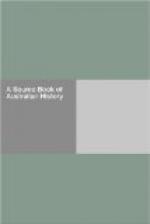At our first coming, before we were acquainted with them, or they with us, a company of them who lived on the main, came just against our ship, and standing on a pretty bank, threatened us with their swords and lances, by shaking them at us; at last the captain ordered the drum to be beaten, which was done of a sudden with much vigour, purposely to scare the poor creatures. They, hearing the noise ran away as fast as they could drive, and when they ran away in haste, they would cry, gurry, gurry, speaking deep in the throat. Those inhabitants also that live on the main, would always run away from us; yet we took several of them. For, as I have already observed, they had such bad eyes, that they could not see us till we came close to them. We always gave them victuals, and let them go again but the islanders, after our first time of being among them, did not stir for us.
THE FIRST VISIT TO THE EASTERN COAST
+Source.+—Cook’s Journal (edited by Wharton, 1893), pp. 237-249, 311-312
Captain Cook was the first Englishman to search for the Great South Land. After observing the transit of Venus, he made extensive explorations in New Zealand, and then sailed West, to seek the East Coast of New Holland.
April 1770. Thursday 19th. At 5, set the topsails close reef’d and 6, saw land, extending from N.E. to W., distance 5 or 6 leagues, having 80 fathoms, fine sandy bottom. The Southernmost land we had in sight, which bore from us W 3/4 S., I judged to lay in the latitude of 38 deg. 0’ S., and in the Long. of 211 deg. 7’ W. from the Meridian of Greenwich. I have named it Point Hicks, because Lieutenant Hicks was the first who discovered this land. To the Southward of this Point we could see no land, and yet it was clear in that quarter and by our Long. compared with that of Tasman’s, the body of Van Diemen’s Land ought to have bore due South from us. The Northernmost land in sight bore N. by E. 1/2 E., and a small island lying close to a Point on the main bore W., distant 2 Leagues. This Point I have named Cape Howe; it may be known by the trending of the Coast, which is N. on the one side, and S.W. on the other.




